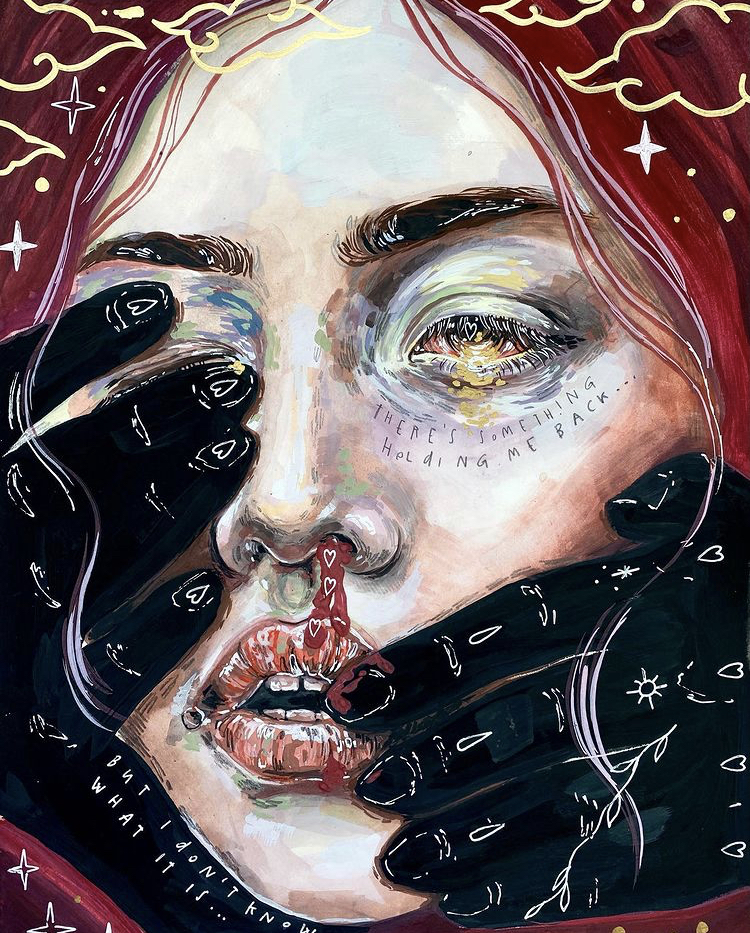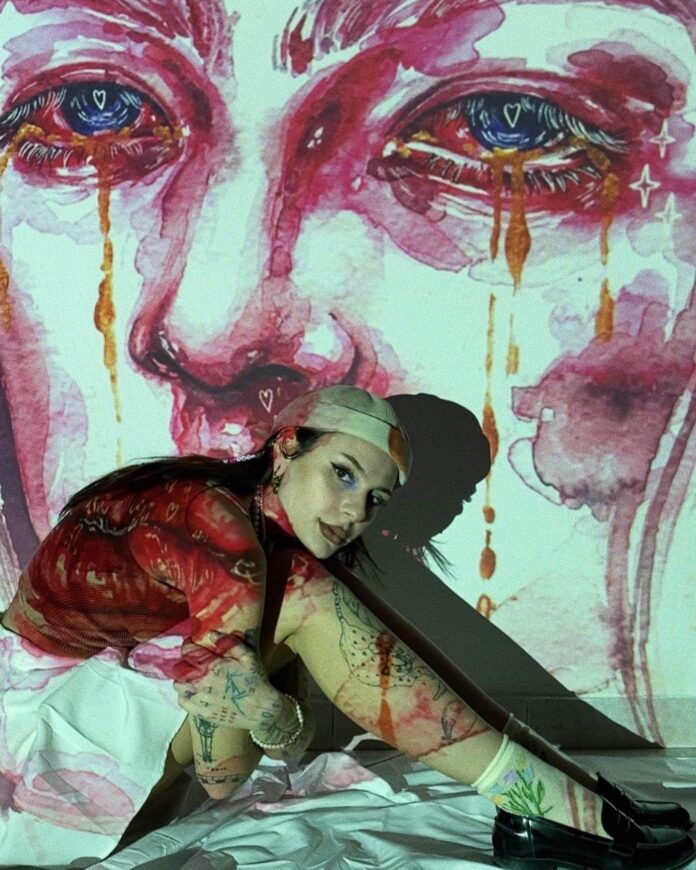Gloria Gorni is a 22 year old painter based in Milan. Gloria’s creative journey began at an early age, influenced by her architect mother’s passion for art. She considers primary school her starting point – since Gloria is severely allergic to bees, her teachers forbid her from spending too much time outside with her classmates, which resulted in many school breaks spent drawing in the hallways. She’s never looked back since. A graduate of the Brera Academy of Fine Art in Milan, the painter has produced a lot of cover art for musical albums, collaborating with Guardin, Muriel, Denis First & Reznikova and Maneskin. Gloria has also worked on illustrative projects for established companies like Mondadori, Tally Weijl and Le Pandorine. At the moment, the artist is working on big murals and illustrating a book. Gloria’s captivating artwork can be found on Instagram and Twitter.
Hi Gloria, how have you been doing lately? How is your day going?
I’m pretty good, thank you! Quite stressed cause I’m working on many different projects but sunny days and springtime are helping me calm down and relax a bit! The weather has been amazing here lately.
I know you’re currently based in the stunning city of Milan, Italy. What significance does the city have in your life?
To be very precise, I live in the suburbs of the city, but by car it’s something like 20 minutes to get to the centre, so I always tell people I live in Milan cause it’s easier to explain. Milan is a beautiful city, full of opportunities and inspiration. I feel very connected to this place since it helped me a lot with my artistic journey. I had the pleasure of sharing my art with talented artists and the city has also offered me some sick job opportunities. Before the whole Covid situation messed everything up a bit, I also held several exhibitions in the city.
Were you born and raised near Milan as well?
I was born here but my parents are originally from other places in Italy. My dad is from Emilia-Romagna and my mom is from Valtellina, so I was raised in wooded areas as well as the countryside.
That’s lovely! Do you imagine yourself living in Milan in the future, or are there other cities in the world you’d like to live in?
I think I’m gonna stay in Milan for a while, since I have my art studio here and my co-worker lives here too, but Berlin is my dream city. I visited it a couple of years ago and I completely fell in love with it. I also think it would suit my concept of art better, offering me more job opportunities and inspiring me to create more.
How was your passion for art born, and how has it developed since?
I started drawing at a young age as an alternative to play. I’ve never been a very social person, so I kind of used it to compensate for my introvert habits. Growing up it became my main channel of expression. Art is just how I communicate my feelings and at the same time my biggest passion and my job. I really consider it a form of self-therapy sometimes, it helps me control and deal with my emotions.

Did you ever go to art school?
Yes, I attended an arts focused high school and I’m actually about to graduate from an art academy! Both of these forms of educational training really helped me open my mind and taught me to look for the beauty in everything, shaping me as an artist but even more so as the human being I am now.
Which artists have inspired you most over the past few years?
The ones that played the biggest role in the development of my art style are surely Marco Mazzoni, Elly Smallwood, Agnes Cecile, Lucas David.
At only 22 years old, you’re a very young visual artist. With so many followers, do you feel like there’s already a pressure for you to conform to a specific style because of your audience’s expectations? Or are you able to experiment and continue cultivating your visual voice with no pressure?
If I’m completely honest, I’m a very insecure person so I’m scared of harsh critique and negative comments, but I think my followers are very open to changes when it comes to my art style. They’re incredibly supportive and I appreciate that, I never feel anxious or pressured in the context of experimentation. Most of the time when I paint something out of my comfort zone I’m very curious about the feedback I’ll receive for that piece. What I’m more concerned about is sharing my private and social life online – I’m very reserved, so I’m also always afraid that my audience won’t like me as a person (but this is totally all due to my insecurities).
Thanks for your honesty. I’m sure your followers would agree that we truly appreciate you as a person as well as an artist! I was also wondering, you’ve produced artwork using gouache, watercolours, oil on canvas… Which materials are your favourite?
It depends mostly on my mood to be honest, on how I’m feeling at that specific moment. I’d say my favourite medium is watercolor, I find it very therapeutic since it’s a technique based on taking your time and meditating on every brushstroke. You have to carefully control how much water you’re using and you have to wait for one layer to dry before moving on to the next. It helps to calm me down whenever I feel stressed. Lately I’ve also fallen in love with oil pastels because with them you can really model the drawing you’re creating and be very messy, but in general it depends on what I want to represent in the piece.
More and more modern artists are venturing into digital artwork. Do you appreciate this style or do you prefer creating non-digital art?
Half of my works are actually digital, made using my iPad, but you can’t really tell cause I mix digital painting with traditional art and I keep the style very similar. I like to work via digital media when I want to paint in a hyper realistic way, to make it more detailed, or when I’m in an environment that lacks sufficient space for painting or drawing. I totally enjoy digital art but my favourite art style will always be traditional, because to me the acts of mixing colours, choosing one brush over another, controlling the brushstrokes, and feeling the paper, are all a fundamental part of success in my art.

Nose bleeds and tears streaming from eyes seem to be a motif in your paintings, often setting a sinister tone in your portraits. Could you comment on the significance of these aspects? Do you simply find them visually appealing?
I started incorporating nosebleeds and sad eyes into my art when I was more or less 16, I believe. I used to paint a lot of self-portraits during this period and since art is my main channel for sharing feelings, it just came naturally to me to express what I was mentally experiencing through visible physical pain in my creations. Ever since then, these aspects just became a distinctive feature of my art style, plus, to be honest, I always found blood very fascinating.
What role has art played in your life during the pandemic? Has it been therapeutic, or have you found it’s difficult to find the motivation and energy to produce art during such tough times?
Actually, I find that as my mood goes down, my will to paint grows. I know that sounds weird, and to be honest, it doesn’t work like this all the time (I have days where I can’t gather enough mental strength to get out of bed), but I try to use it as a coping mechanism cause I always feel better after drawing or painting. So sometimes it’s more like a necessity, not something that I have to feel motivated to do.
Do you feel like the role of art is entirely different now than centuries ago, or does the fundamental mission of art in society always remain the same?
Absolutely, the role of an artist keeps changing as society evolves. In the past, artists used to be considered craftsmen, very skilled in carrying out their work – especially manual work. They used to have a more ‘functional’ role in the society, working for religious or aristocratic clients, and they were not seen as creative people like they are nowadays, but rather as skilled professionals, able to paint and craft a realistic portrait to hang on the walls of a castle. My high school art teacher used this example to make us understand this concept: think about the insides of the churches, full of paintings of different Biblical scenes. They weren’t created because of their decorative function, but because at that time most of the population was illiterate, so artists transformed text into images to transmit the ideas of the Bible. The role of the artist as we see it now began to be built, in my opinion, along with the development of Romanticism, and it took shape with the ‘Salon des Refusés’ in 1863, and with the Impressionist movement in general. Nowadays, I believe that art fully rules our daily lives, even if we’re not completely aware of it. Artists have to leave an impression on people, make them feel something, make them laugh or cry or just make them think about something, stimulate them, but also provoke them. Or just fascinate people with beauty.

You recently published a gorgeous celestial piece captioned “you’re so golden”, inspired by Harry Styles’ single. I was wondering, what music have you been listening to lately when creating art? Does music inspire any of your creations?
Thank you so much for your nice words! Music has always given a massive contribution to my art since it’s a very big part of my daily life. I can’t imagine creating something without listening to music. My favourite music genres are alternative, indie, lo-fi and hyperpop/pc music, but I genuinely listen to everything, from Harry Styles, as you can tell, to Crystal Castles. When I paint I usually prefer lo-fi music since it really helps me focus on the artwork.
Lastly, I was hoping you could talk us through how you come up with the text that accompanies your artwork. Do you add it at the very end?
It really depends. Sometimes it’s the starting point of my creative process of an artwork, so I get inspired by a text, song lyrics or poetry to create something related to it. Other times, I just use words to better underline what I wanted to communicate with that piece of art. They can also just be something that really needs to exist in a specific painting, I can’t put it any other way. It’s like some of my paintings don’t feel complete without a certain text in it.
Thanks so much for your time, Gloria.

